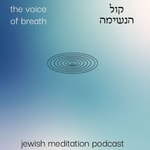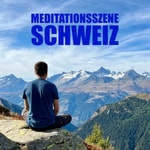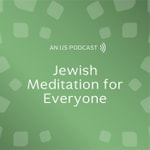The Voice of Breath – Details, episodes & analysis
Podcast details
Technical and general information from the podcast's RSS feed.


Recent rankings
Latest chart positions across Apple Podcasts and Spotify rankings.
Apple Podcasts
🇨🇦 Canada - judaism
21/11/2024#91🇨🇦 Canada - judaism
20/11/2024#74🇨🇦 Canada - judaism
19/11/2024#62🇨🇦 Canada - judaism
18/11/2024#43🇨🇦 Canada - judaism
17/11/2024#22🇫🇷 France - judaism
01/11/2024#90🇫🇷 France - judaism
05/09/2024#89🇫🇷 France - judaism
04/09/2024#67🇫🇷 France - judaism
03/09/2024#91🇫🇷 France - judaism
01/09/2024#97
Spotify
No recent rankings available
Shared links between episodes and podcasts
Links found in episode descriptions and other podcasts that share them.
See all- https://www.jewishspirituality.org/
95 shares
- https://www.friendsofroots.net/
3 shares
- https://www.miraneshama.com/
2 shares
RSS feed quality and score
Technical evaluation of the podcast's RSS feed quality and structure.
See allScore global : 38%
Publication history
Monthly episode publishing history over the past years.
Faith in a Turbulent World Part 3: The Heart of the Book, the Heart of the Nation
Episode 22
lundi 12 août 2024 • Duration 30:38
This is Part 3 of our shiur series exploring the Book of Eicha based upon the writing of Dr. Yael Ziegler. In this shiur we explore the overall structure of the book and come to its core message.
Faith in a Turbulent World Part 2: A Theology of Suffering
Episode 21
lundi 12 août 2024 • Duration 01:06:24
This is part 2 of our series exploring the Book of Eicha based upon the writing of Dr. Yael Ziegler. In this shiur we explore whether Eicha presents a theology of suffering, meaning, why do bad things happen to good people?
Dr. Mira Neshama Niculescu + Hitbonenut (Contemplative meditation techniqu)
Season 1 · Episode 11
vendredi 20 août 2021 • Duration 51:52
We sit down with Dr. Mira Neshama Niculescu and discuss her journey through Zen meditation to Jewish meditation, her studies on the JuBu phenomenon and the incredible work she does teach Jewish meditation worldwide.
(38:41) Is when the meditation begins
Dr. Mira Neshama Niculescu is a Paris -born scholar and teacher of Jewish spirituality and meditation. She received her Doctorate in Sociology of Religion from the Ecole de Hautes Etudes en Sciences Sociales in Paris and is a Post-Doctoral Research Fellow at the Hebrew University of Jerusalem and at the Center for Hebrew and Jewish Studies in Oxford.
A former Arts Fellow from the Drisha Institute of Jewish Education and a certified Experiential Jewish Educator from the Pardes Institute of Jewish Studies as a Yesod European Leader Fellow, she currently learns Torah as a rabbinic fellow at Beit Midrash Har’El in Jerusalem.
A certified Jewish Mindfulness Teacher from the Institute for Jewish Spirituality, she teaches Torah and Jewish meditation for Or HaLev, Applied Jewish Spirituality, Romemu, IJS, Moishe House, and at various institutions in Europe and in the United States.
https://www.appliedjewishspirituality.org/experiencing-jewish-meditation
https://romemu.org/about/yeshiva/
https://www.jewishspirituality.org/
https://www.friendsofroots.net/
The Overview Effect: Visualizations for Ego Transcendence
Season 1 · Episode 10
mercredi 18 août 2021 • Duration 23:04
In 1987, Frank White coined the term "The Overview Effect," describing the experience of astronauts viewing the earth from space as a unified organism. In this episode, we discuss this phenomenon, as well as share a "Visualization for Ego Transcendence," from the book "Visions of a Compassionate World," by Rabbi Menachem Eckstein.
(08:39) The meditation begins
Theme music is the song "Breathe" by Feter Hendel
Moshe Hendel Feiglin and the power of the Niggun (wordless melody)
Season 1 · Episode 9
lundi 16 août 2021 • Duration 43:57
In this interview we sit down with dear friend Moshe Hendel Feiglin, to learn of his journey, his musical expression and the power of the Niggun (wordless melody) to transport an individual and bring them into contact with the Divine. Moshe wrote the song "Breathe," our theme song, and recorded it with his band Feter Hendel.
The episode finishes with Moshe's rendition of the Poltover Niggun
Duncan Trussell, the JuBu phenomenon + A Stepping into Nature Meditation
Season 1 · Episode 8
dimanche 15 août 2021 • Duration 20:31
(8:32) is where the Meditation intro begins if you wish to skip over my banter ;)
In this episode we discuss the phenomenon of the JuBu (Jewish Buddhist) based upon an episode of Duncan Trussel, as well as share a brief Nature-based meditation to help ground and connect (Please note, real actual nature is not required, but certainly beneficial!)
Bringing in Shabbat meditation
vendredi 13 août 2021 • Duration 17:06
Rabbi Daniel Kohn- His journey, the power of music + The ancient technique of Shehiyah (Pausing)
Season 1 · Episode 6
jeudi 12 août 2021 • Duration 01:25:27
Rav Daniel is the rabbi of the Community of Bat Ayin, musician, spiritual guide and counselor to individuals and groups, and beloved teacher of transformative Torah. I merited to learn from Rav Daniel and his Torah has played a foundational role in who I am. I think you will understand why after hearing this interview.
(48:03) is when the first meditation begins - "There is a Place with me"
(54:26) is the second meditation - "Shehyah (Pausing)"
To learn more from this incredible teacher you can find him at:
Soundcloud - go to playlists to find shiurim and more
A beautiful video on contemplative prayer
Plus! Stay tuned for more information about the exciting SiddurLive project!
The theme music is the song "Breathe" by Feter Hendel
Introduction to Rabbi Aryeh Kaplan + The Visualization of the Name of God
Season 1 · Episode 5
mercredi 11 août 2021 • Duration 21:11
In this episode, we share some brief remarks about Rabbi Aryeh Kaplan's z"l impact on Judaism in general and Jewish meditation in specific. We also share a short visualization technique garnered from Rabbi Kaplan's classic "Jewish Meditation: A practical guide."
(06:34) The meditation begins
The theme music is the song "Breathe" by Feter Hendel
Rabbi Dr. Meir Sendor + Kabbalistic Vocalization Technique of Rabbi Avraham Abulafia
Season 1 · Episode 4
mardi 10 août 2021 • Duration 59:05
Today we talk with my father, Rabbi Meir Sendor, about his journey and teachers, and discuss how Jewish meditation differs from other meditative traditions. We conclude the episode with the Kabbalistic vocalization meditation of Rabbi Avraham Abulafia.
(48:32) If you wish to just listen to the meditation - There's a guide below.
Rabbi Meir Sendor, Ph.D., serves as the facilitator for Tal Orot.
After serving as the rabbinic leader of the Young Israel of Sharon for thirty-two years, Rabbi Sendor and his wife Anne moved to Tzfat, Israel in the summer of 2016. With rabbinic ordination from Yeshiva University and a doctorate from Harvard University in medieval Jewish history, with special expertise in the history of Kabbalah and Jewish philosophy, Rabbi Sendor teaches a wide range of subjects, from kabbalah, philosophy and hasidism to talmudic and biblical commentary, halakhah and ethics. He uses his three decades of experience teaching Torah and meditation in the Sharon and the Greater Boston area to implement this program in Israel.
A Brief Guide to the Basic Vocalization Meditation of Rabbi Avraham Abulafia
The most basic, essential skills in meditation practice are learning to quiet the mind, stabilize attention and expand awareness. Some people find direct methods for quieting the flow of verbal mental chatter to be difficult at first. In some cases, an indirect approach can be helpful, such as the following basic vocalization method of the thirteenth century kabbalist Rabbi Avraham Abulafia.
On the whole, Rabbi Abulafia’s meditation techniques are highly rigorous and complex. His advanced techniques involve meditations on the divine Names, requiring great purity and sanctity of mind and body. But the basic method that he describes in his manual Or HaSekhel (pp. 101-05) is accessible for everyone. As he states it, “when your mind comes to adhere to His mind that grants you mind, your mind needs to remove from itself the yoke of all alien thoughts, except for His mind that is shared between you and Him by virtue of His glorious and awesome Name.” To attain this stable awareness, the following meditation can be helpful. This is a summary of his instructions.
As general preparation, sit in a quiet and comfortable location, with your back straight, feet on the floor, hands resting on your legs. If you are sitting on the floor, let it be in a way that your back is nice and straight. Sit quietly with your eyes closed for a few minutes, clearing your mind as well as you can.
This is a vocalization meditation, in which we will be expressing the five essential vowels of Hebrew in connection with the letter Aleph, which has no sound itself. Hebrew has nine vowels, but Rabbi Abulafia notes, and the linguists agree, that there are five essential vowels. We will express them in the following order: Cholem= oh; Kamatz= ah; Tzeirei= ai; Chirik= ee; Shuruk= oo.
We take a natural, deep breath, our head in normal position facing straight ahead. Beginning with the Cholem, we express the vowel on the exhale, letting the sound ride on our breath at a comfortable volume, out to the very end of the breath. While expressing the Cholem we raise our head slowly and gently upwards (the Cholem vowel is written above the letter). Then we inhale once, through the nose (to avoid hyperventilation), as our head slowly returns to normal position. Then we express the Cholem again on the exhale, out to the end of the breath, lifting our head gently upwards. Inhale again through the nose as the head returns to normal position. We repeat the Cholem five times total, inhaling through the nose after each exhale.
Next we express the Kamatz in the same way, five times, out to the end of the breath, this time slowly and gently moving the head horizontally from right to left over the course of the exhale (this vowel is written horizontally), then back to the right on the inhale.
Next we express the Tzeirei in the same way, five times, out to the end of the breath, this time moving the head from left to right on the exhale (this vowel is also written horizontally), then back to the left on the inhale.
Next we express the Chirik in the same way, five times, out the end of the breath, this time moving the head from normal position down towards the chest on the exhale (this vowel is written as a dot under the letter), then back up to normal position on the inhale.
Finally, we express the Shuruk on the exhale, five times, out to the end of the breath, this time moving the head from normal position very slightly forward on the exhale (this vowel is written in the middle of the letter), and returning to normal position on the inhale. After the last expression of Shuruk we sit quietly for several minutes.
We have provided a recording of this meditation which you can use to follow along for the first few times, to get a feel for the sound and the pacing. A chime sounds at the beginning, to introduce a minute of silence before the vocalization series, and a chime sounds at the end, after a few minutes of silence. Throughout the meditation, you can be aware of the vibrations that each vocalization stimulates. After the vocalizations, you may find that it is relatively easy to maintain a quiet, open, attentive and stable awareness.
Rabbi Abulafia goes on to expand this meditation to include letters and vowels of the divine Name, but that’s for advanced meditators in a high state of purity. Even this basic form of the meditation, however, can be helpful towards connecting our mind with HaShem, Who grants us mind, with HaShem’s help.
Rabbi Meir Sendor, Tal Orot









